As agilists, we all hear a lot about self-organizing teams. I'm pretty sure I have already aired several, probably conflicting, opinions about self-organizing teams, like "
someone else should assign people to the teams and decide what they should do, and THEN they should self-organize," but today I would like to talk about something even more fundamental: the self-organizing self. Are you fully able to function on your own behalf, or even on the team's behalf, at times when you don't have a scrum master acting as a sort of personal time assistant? Do you procrastinate? Are you distracted? Do you run out of money? Do you lose things? Let's assume you've tackled work--how well-armed are you for life?
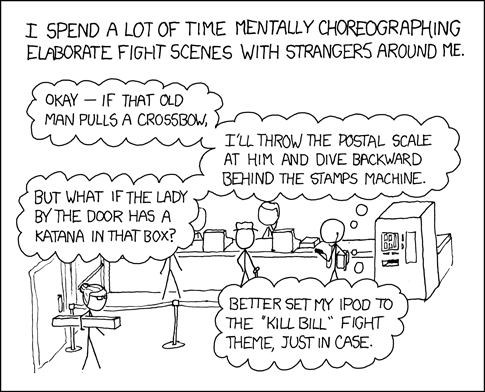 |
| Helpful advice from http://xkcd.com/337/ |
I would like to think that most of you are more personally organized than I am, and you probably are, but for those of you who need a little help, as I do, there are some free or cheap techniques and online tools that can help arm you for the struggles of day to day life. These have worked for me--perhaps some of these will help you as well. Today's tips focus in four areas to organize: things, tasks, time, and money. If none of these are areas of personal challenge for you, then move along, there's nothing for you here! Otherwise, here we go. Let's start simple, to avoid frightening ourselves:
Don't lose things. Sure, it sounds basic, and yet how many things have you lost this month? My advice is that you just keep everything in your purse, man bag, laptop bag, backpack, briefcase, or, if you have somehow managed to miss the memo, "fanny pack." If it is not important enough to keep in your purse, then you can do whatever you want, but don't come running to me if you can't find it in an emergency. Most things that won't fit in your purse are harder to lose, in any event.
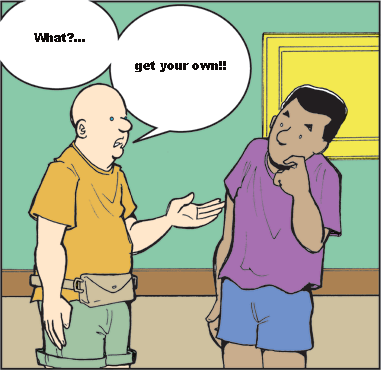 |
| From http://www.examiner.com/article/international-fanny-pack-day. Isn't that a horrifying concept? |
Pro usage tips:
- Never, ever, keep something "in your hand." If you notice something in your hand, put it back in your purse.
- When you use something, make sure it is actually "in use," "being charged," or back in your purse. You can charge things located in your purse if you don't mind the cords dangling out of there.
- Do not charge gadgets on the floor, because you might step on them.
Tasks. I have heard many folksy anecdotes about people who use a card wall for tracking their family chores at home. Good for them. For many of us disorganized people, the problem isn't "delivery." The problem is "keeping track of the backlog." Or in layman's terms, "having an un-lose-able list of things to do." You could do this by having a piece of paper you keep in your purse. And a pen. But if the challenge level of keeping a pen handy has already caused you to break out in a sweat, I recommend you get "personal productivity software." There are a bunch of these out there, but I personally recommend
Toodledo, which
as this reviewer says, is:
"Too robust to be called a simple to-do list, ...not quite powerful enough to be called a project management tool. Despite the lack of a handy category to slot them into, this is a nifty tool for anyone with a complicated life." The basic idea is that you put stuff on the list when you remember you have to do it, check the list on some regular cadence, and check things off when they are complete. It's pretty neat! You might like it. Here's a screen shot of the web application:
Pro usage tips:
- There's an app for that. You can get apps for iphone and Android for toodledo, which means that every time it occurs to you that there's something you need to do, you can jot it down immediately, using whatever gadget you have handy. Do that.
- Avoid nagging. You can give your partner, spouse, or other loved one your login and password to the free version, and get them to put things directly on your toodledo list instead of nagging you. Or you can pay for the official multi-user upgrade, if you need more privacy.
- Toodledo is Covey-highly-effective-person-friendly. Once you have a way to keep the list and not lose it, you can try advanced practices like "figure out what is important and plan that first." If you need to do some heavy duty life planning, you will want to use the web interface, though, not the app.
Time. There are many people out there making tons of money on this topic, and you can go out and buy their books if you want. But if your issue is just being distracted and getting to the end of the day without anything to show for it except a new high score in Candy Crush, you may want to bring in the heavy weaponry:
the Pomodoro Technique.
 |
| A branded kitchen timer |
Pomodoro was invented by a graduate student who actually wanted to finish his dissertation and to move into the paying work force. Some graduate students do want to leave school eventually! The Pomodoro inventor used a a piece of paper, a pen, and a red kitchen timer shaped like a tomato (hence the name--"Pomodoro" is Italian for "tomato"). If you do not have a red kitchen timer handy (or a piece of paper and a pen), then you can use an application on your laptop or smartphone to simulate these objects. My choice of tool is an Apple-centric product called
Vitamin-R. I'm not sure what the smartphone or not-Apple-computer equivalents are, sorry.
In essence, at the start of the day (or the night before), you take your list of things to do (like, from toodledo...), figure out which ones are realistic to do today (or tomorrow), and slot them into 25 minute segments called "Pomodoros." Typically, your day will be set up in sets of Pomodoros, interrupted by scheduled breaks. To avoid frightening yourself, you don't call this a schedule. You call it an "unschedule." I swear, I didn't make this up.
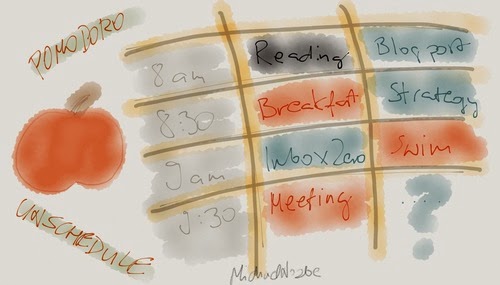 |
| From fan site http://www.michaelsliwinski.com/power-of-unschedule-and-pomodoro-technique/ |
Classically, you agree to work without stopping for 25 minutes, then take a 5 minute break. Then you do another 25 minutes and another 5 minute break. After you do four of these, you take a nice long break, like a coffee break or a meal break. And you make sure to take those short breaks, as well. Unless you allocate an entire Pomodoro to "reading email," you will need to fit your emailing, tweeting, facebooking, etc., into the break time. You will be amazed how much you can get done when you make a promise to yourself to focus for just 25 minutes at a time. So your day might be:
- 2 hours of Pomodoros (4 Pomodoros)
- 30 minute break
- 2 hours of Pomodoros (4 Pomodoros)
- 1 hour break (for lunch)
- 2 hours of Pomodoros (another 4)
- 30 minute break
- 2 more hours of Pomodoros (final 4).
The rules are "do nothing but work during a Pomodoro" and "do NO WORK when you are NOT in a Pomodoro." You can see in the above schedule, you get 7.75 hours of productive work, which may even be more than you get today with your lassaiz-faire "I think I'll just play some foosball with the guys and work until midnight" methodology.
Pro usage tips:
- Don't freak yourself out or overthink this. You can plan the whole rest of your life once you've gotten the basics under your belt. Just do this one Pomodoro at a time, one day at a time.
- If you are using Pomodoros to schedule your personal time as well as your work time, you will likely schedule a couple of Pomodoros at the beginning and/or end of the day.
Manage your money. I am sure this doesn't happen to you, and of course not to me, either, but just in case, let me say speculatively that I bet it is really inconvenient to just up and run out of money unexpectedly. Don't let this happen to you. I'm not sure what the whole market out there is for this type of tool, and I'm not sure whether these are available outside the US, but for what it's worth, I use two cash flow related tools:
mint.com and
YNAB ("You Need a Budget.")
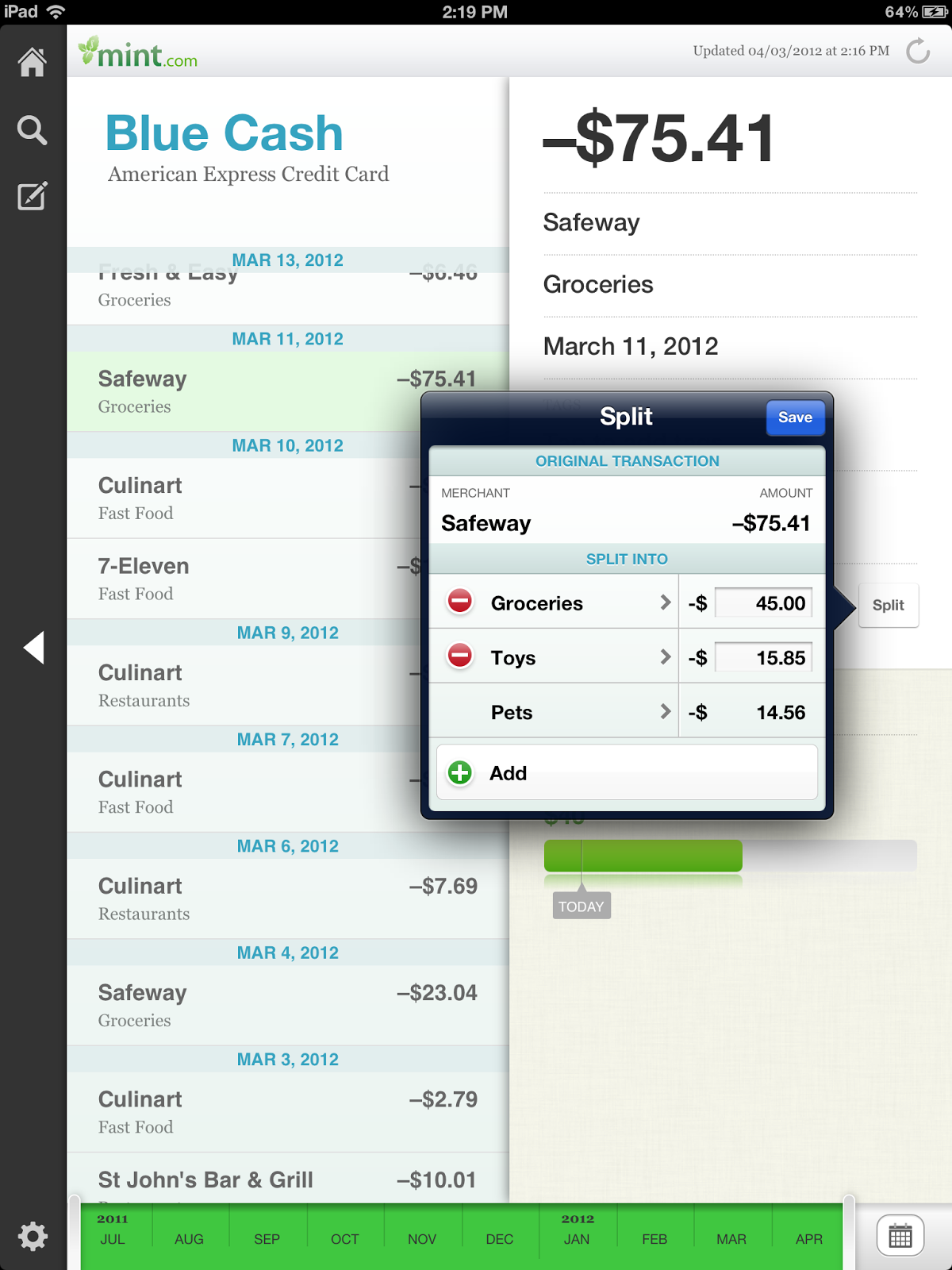 |
| mint.com shows you when you have run out of money |
Both applications can be used from a laptop, and both have iPhone and Android apps to access the same basic data, as well. Mint.com lives in the cloud, and easily hooks up to almost any US financial institution and provides handy alerts like "just dipped below zero" when that happens in real time. For a tiny bit more control, you can use YNAB to actually plan where you will spend your currently available dollars.
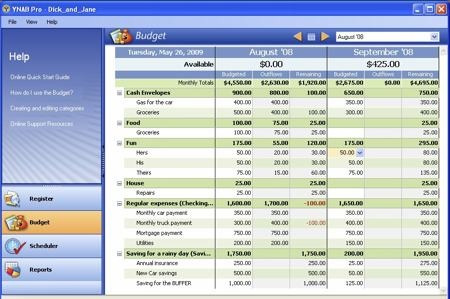 |
| YNAB action shot, laptop interface |
YNAB is different from other tools you may have used, like Quicken, Microsoft Money, or even mint.com, in the sense that it asks you to just focus on what cash you have, and how you plan to spend it. It does not let you get pulled into an endless categorization of last year's data. That's nice.
Pro usage tips:
- mint.com has a budgeting tool, but it is cumbersome, and you will get lost in there and never come out. Just use mint.com to tell you whether something terrible has just happened or not.
- YNAB lets you just focus on what cash you have on hand, and what you plan to spend it on. You can gradually move into planning one or even two months ahead, but you don't have to.
So there you have it! Things, Tasks, Time, and Money. All under control. Isn't that fantastic? And if you like, you can extend this winning streak by looking into house cleaning and organization with the
Flylady, who is completely adorable, and will help you get your home in order, starting with the kitchen sink. She is awesome.
So by now, some of you may be saying, "seriously!?"or the like. I had hoped you people would go away earlier. For the rest of us, let me just say, yes, I understand! No matter how hard your work is, it may be a picnic compared to the complications of modern life. Before you start organizing your self-organizing team, take a few minutes to organize your self.







Comments
Post a Comment